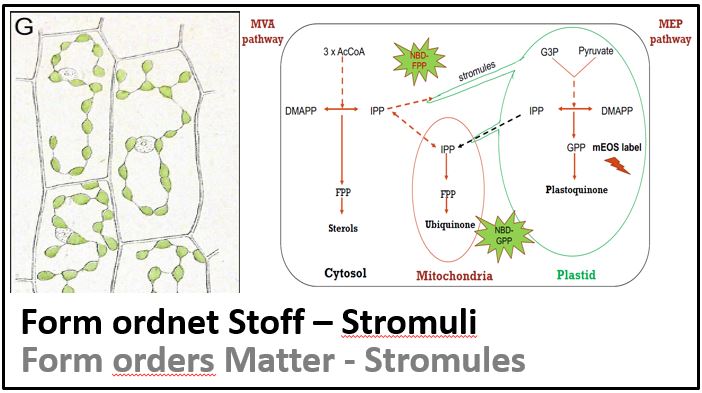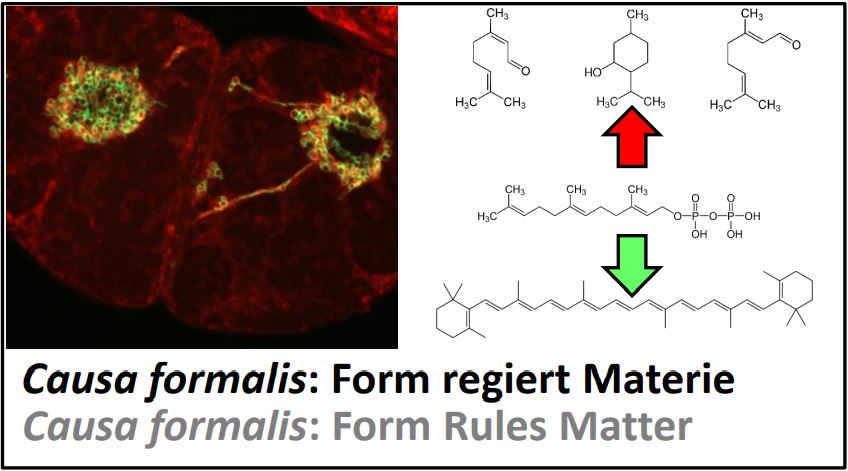 Plant Cell Biology 2023
Plant Cell Biology 2023
Stromules are protrusions formed by plastids under certain conditions. First discovered in the 19th century, they were later forgotten and "rediscoved" in the 1990ies. They were thought to form a network of plastids within the cell, but this was then disproven by the elegant experiments of Martin Schattat and Jaideep Mathur using photoswitchable fluorescent proteins. We want to understand, what stromules are doing and we can show that they are inducible by the jasmonates (plant stress hormones). Since the plastids are the main chemical factories of plants, change of their shape might lead different channelling of metabolic pathways. In other words: form rules matter. Can we test this idea experimentally? Ongoing work has shown that the stromules can be induced by certain hormones, such as methyl jasmonate or salicylic acid and that they need microtubules to be formed, which means, we can disrupt them by the anti-microtubular compound oryzalin. We have already found out that the jasmonate precursor OPDA can be rechannelled by stromules to the mitochondria, such that less is transferred to the peroxisomes (where it undergoes beta-oxidations into the mature jasmonic acid). Since OPDA has meanwhile been recognised as being a hormone by itself, we wonder, whether stromules channel OPDA for a different purpose. We suspect that the target might be mitochondria that are under stress and, therefore, accumulate reactive oxygen species. Are friendly plastids using stromules to "tap on the shoulder" of their stressed fellow mitochondria to calm them down and to help them in coping with oxidative stress? However, we have recently made a second, more shocking discovery: Farnesyl Pyrophosphate (GPP), a precursor of terpenoids that are made in the plastid, does not go straight to its final destination, but first lingers in some structures that look like mitochondria, from where plastids pick it up through stromules. Are stromules fingers that do not give, but take? We are not sure, but using a fluorescent mitochondrial dye, you can find out. Background and protocols . Bachelor thesis on stromules .
causa formalis - Form regiert Stoff
Our view on cells has undergone a strong change. While in the 1940ies, when biochemistry was dominating, cells were often depicted as "bags full of enzymes", the discovery of electron microscopy allowed to discover the complex inner structure of organelles and membrane compartments. This appeared a bit rigid, based on a methodology that required chemical fixation of the cells. Only the breakthrough of fluorescence and confocal microscopy from around 1990 allowed to visualise the dynamics of molecular events in living cells. Despite the extensive knowledge on the dynamic architecture in the interior of cells, molecular biology is often shaped by static images, agains caused by methodology - molecular genetics deals with genotypes that will not change during the lifetime of an organism. What is still missing, is a synthesis between molecular genetics and cell biology. Here, we want to launch a new approach demonstrating how molecular events in cells can be steered by changes of shape. Form rules matter. As model we have selected stromules. These are extensions of plastids that form mainly under stress conditions. Discovered by Schimper already at the end of the 19th century, they were forgotten later and rediscovered only in the 1990ies by means of plastid localised GFP markers. The initial idea that plastids connect into a network through stromules, was later dismissed by elegant experiments by Mathur and Schattat. The stromuli just touch other plastids, but also other organelles such as mitochondria or peroxisomes. What the function of these stromules is, has remained enigmatic. We have now picked jasmonate biosynthesis that initiates in plastids and continues in peroxisomes. We think that stromules can rechannel metabolism, such that the precursor OPDA accumulates that triggers its own, specific signal transduction. Our idea is basically that cells depending on the conditionas can render "metabolic decisions" that are then put into practice through shape changes of the plastid.

